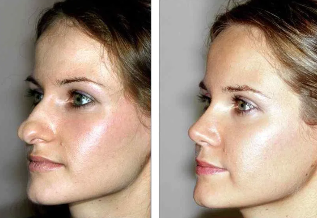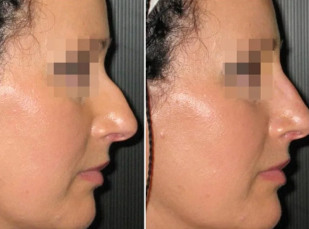Eyelid surgery – this is one of the most popular plastic surgeries, suggesting manipulation in the area of the nose. The task of this procedure – restore the correct shape of the nose, which was disrupted due to injury, disease or congenital diseases.
The history of the development

You may think that the operation of the nose – it is a recent invention, and resorting to the services of doctors completely a pair of stars and models. This is not so. The first mention of the technique to restore the nose belongs to the ancient times. Similar operations are carried out in India for 1000 years bc Indian doctors have damaged noses, while the skin of the face of the patient.
In Europe, the nose got development in the middle Ages. Italian doctors described their own way re-create the shape of the nose from the skin of the face. In the 19th century this kind of operations got new development, and thanks to the efforts of the English and German doctors. There are new techniques based on the experience of the indian doctors.
Initially, the aim of the operation was to restore a damaged nose, cosmetic and aesthetic factors purchased importance already at the end of the 20th century.
Medical indications for operation
Any type of surgery might be called the creative process, and rhinoplasty – this is not an exception. Mixes solutions to aesthetic problems with the restoration or preservation of function of the organ (normal nasal breathing).
So, it is a surgical procedure can pursue as therapeutic, and aesthetic goals. It is best to do the surgery at the age of 25-30 years, when the cartilage is completely created. Of course, the recommended age may vary depending on individual circumstances.
Medical indications:
- Violation of nasal breathing or complete lack thereof.
- Traumatic damage, which led to changes and deformation of cartilage and bone.
- The physiological and compensatory curvature of the nasal septum.
- Congenital curvature or deformation of the nasal septum.
- Cysts and polyps in the nose.
- Hypertrophy of the nasal shells.
Violation of the anatomical structure of the nose lead to different functional complications and morbid conditions. They can be: otitis media, rhinosinusitis, bronchial asthma, snoring, frequent respiratory diseases, atrophy or hypertrophy of the shell of the nose, difficulty in nasal breathing.
This is particularly dangerous, a violation of nasal breathing for children. It can be the cause of lack of oxygen in the brain, leading to mental and physical lagging in development. Operation restore respiratory function can be assigned to 18 years.
Aesthetic indication for surgery
More than half of the operations to change the shape of the nose is performed for cosmetic reasons. Patients want to achieve harmony in their appearance. Aesthetic indications for performing plastic surgery can be divided into two subgroups:
- Objective. When the nose is disproportionate in size, shape.
- Subjective. In this sub-group include mainly psychological reasons, which is related with the evaluation of their own appearance. For example, the patient doesn't like, there is a small hump or inverted.
Psychological causes are often associated with a professional or social environment. In the patient appear complexes, acute dissatisfaction with their appearance.
Aesthetic indications:
- Curvature of the nasal septum.
- Acquired and congenital deformation.
- Its disproportionate size in relation to a person, when the nose seems to be too big or too small.
- The saddle shape of the nose.
- Hump.
- Too wide nostrils.
- Unattractive form, when the tip of the nose bifurcations, skip, raised, thickened, or sharpened.
- Asymmetrical nose.
- Correction of unsuccessful operations.
It is important to note that in the result of the operation is not always possible to get a perfect result. In surgery, there are limitations, so the rhinoplasty should be viewed as a correction of the existing forms.
Contraindications

Before your surgery, many patients are advised to visit a psychologist. There are cases, when the patient has a normal shape of the nose without aesthetic or functional disorders. Then problem solve after work with a psychologist.
A plastic surgeon can perform special measurements, and to say exactly whether there are defects. There are certain parameters under which it is assessed, as is the shape of the nose, so the harmony of its provisions on the forehead, eyes, mouth, chin, ears. On the recommendation of a doctor can be modeled on a computer projected appearance after the surgery.
Contraindications:
- Age restrictions. The procedure is not suitable to carry up to 18 and after 40 years. These restrictions may be lifted from the grounds of objective causes.
- Diabetes, kidney disease, liver, cardiovascular system.
- Folliculitis and acne in the area of the nose.
- Violation of blood clotting.
- Oncology.
- Psychological disorders.
- The period of menstruation.
Kinds of the nose
Depending on the persecuted of the objectives and techniques of operative surgery surgery of the nose is divided into several types.
The aim of eyelid surgery can be:
- Reconstructive. It's saving the disorders, which arose due to illness, injury, malformation of the fetus.
- Aesthetic. The correction of cosmetic defects.
During the operation can be performed:
- Enlarging or reducing the nose.
- The liquidation of the hump.
- Repair of saddle shapes of the nose, then there is a solution to the deepening.
- Correcting the shape of the tip of the nose.
- Septoplastike (this correction of the nasal septum).
- Post-traumatic reconstruction.
According to the method of access surgery can be open and closed. The internal method is used in aesthetic surgery, because it is less traumatic. In this case, all incisions are made inside the nasal cavity. The skin is separated from cartilage and the surgeon can easily adjust the shape of the, work with the bone and cartilage of the cloth, to remove its excess or build up with the help of implants. After handling the cuts gently filed.
Open rhinoplasty is applied in complex cases, to correct the serious changes and the implementation of a large volume of transactions. The cut is made on the skin fold between the wings of the nose. In this case, the surgeon gets a good access to the tissues, cartilage and bone. Healing in this method occurs for longer, remains a significant postoperative scar.
Non-invasive rhinoplasty
Non-invasive rhinoplasty – is not an alternative to surgical intervention. However there are methods allowing to correct minor flaws.
Eyelid surgery the help of detectives (special cosmetic gels) will help to adjust the small flaws, soften sharp corners, to restore the symmetry, change the shape of the toe. The application of the filler allows you to disguise the little bump, remove the emptiness, rounded toe.
The recovery period after such intervention takes place the more easily, the price of the procedure is low in comparison with the full-fledged operation. However, the effect of fillers persist only for a few months (maximum 1.5 year). In some cases it is on the site of the injection formed a fibrous fabric, and the overall effect of this procedure is maintained for the upcoming years. But most often it is necessary to repeat the procedure. There is the likelihood of complications: migration of the injected gel and the change of the structure of tissues with repeated injections.
By using injection you can not only start, but also to remove the tissue. There are drugs on the hormonal basis, which may remove bumps, lumps and even in some cases the hump. While the introduction of these drugs is very important to use caution. Often this procedure is performed in several stages. After 2-3 weeks it will be noticeable result.
Using special thread it is possible to adjust the shape of the wings of the nose, and even tighten up the tip. Are set yarn over needle, on the spot, which can form scars. The fibers may tear because of the mobility of the nose. For these reasons, doctors rarely resorted to such procedure.

Preparation for surgery
For successful operation it is necessary the interaction of the patient and the doctor. Before the intervention takes place consultation, where the doctor will explain to the patient that he will be to achieve the desired result.
Held a joint study: analysis of blood, a study of its coagulation, urine, ECG, screening for HIV, hepatitis, syphilis.
If necessary, held a special warehouse, performs image. If there is a chronic disease, then you will need the advice of a therapist or a profile of the expert. The intervention will be postponed in case of deterioration of chronic diseases, the occurrence of acute respiratory disease or infectious lesions of the skin. Before the operation will be held a discussion with the anesthesiologist.
The doctor recommends to give up alcohol, smoking, rule out heavy meal, stop taking hypnotics and sedatives drugs. For two weeks, until the intervention is necessary to stop taking aspirin and its analogues.
Complications
Rhinoplasty is one of the most challenging plastic surgeries, so how important is the aesthetic and functional page. Complications arise depending on various factors in 4-15% of patients. It is possible to divide the operating and post-operative.
Surgical complications:
- bleeding;
- breaks in the skin;
- violation of the integrity or fracture of the bone;
- edge of the cartilage flap, etc.
Postoperative complications:
- loss of sense of smell;
- loss or reduction of sensitivity of the nose and the lower lip;
- difficulty with nasal breathing;
- atrophic rhinitis;
- the deterioration of the right cosmetic lack or absence of changes;
- psychological complications (the patient does not accept the change in appearance, he doesn't like the new face);
- swelling of the nose and eyelids, inflammation, suppuration;
- pigmentation of the skin, formation of skin growths, capillary grid;
- frequent or prolonged bleeding from the nose;
- necrosis.
The most dangerous complications that can occur during surgery – is it an allergic reaction to the anesthesia. Anaphylactic shock can lead to death in 20% of cases.
Convalescence
The patient can leave the clinic a few hours after the surgery or stay overnight for observation. The main recovery after the repair of the nose lasts for 3 weeks. Complete recovery comes up for half a year – year.
The seams and plaster Longuet will be cancelled after 1.5 week. 2 more weeks can not take a hot bath, wash off with warm water – this can cause bleeding, hematomas, swelling of the face and neck. Sleep on your back lying. Not tilt, lift weights. In dusty places, it is necessary to wear a mask.
Within three months it should be carefully kept against impacts and pressure on the nose, do not wear glasses, masks, hard hats. It is prohibited in the pool and sunbathe. The surgeon may introduce additional constraints, dictated by the individual condition of the patient.
The results of the operation
The healing of cartilage and bone tissue takes several months. The final result of the surgeon and the patient will be able to assess roughly 8 months. The decision to do a rhinoplasty (especially if it is missing completely clear testimony) may be perceived by others negatively, so the patient should be ready for the ambiguous reactions from the loved ones and friends.
Relatives may be unhappy with the loss of family or ethnic features. However, often the patient himself and his loved ones, do not see a special effect such an operation, such as swelling of the hide changes, and they manifest themselves gradually.
Eyelid surgery is able to completely change the appearance, but there is no need to believe that with the help of plastic surgery is possible without restrictions of fashion, all presented in the imagination. Any operation – a thing dangerous, can lead to complications and even to the deterioration of the defects. So to treat such injury is to be taken seriously, carefully consider the potential benefits and risks of negative consequences.




















